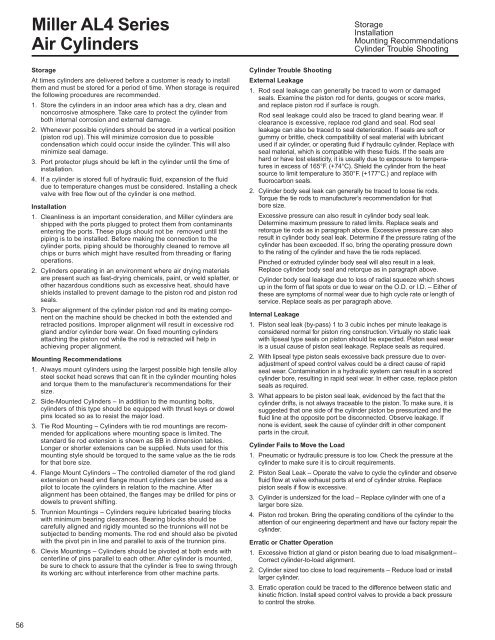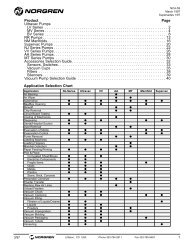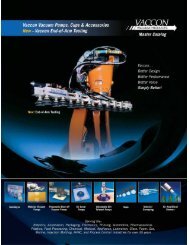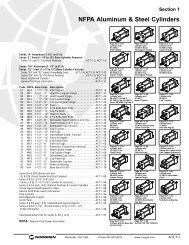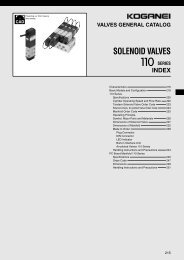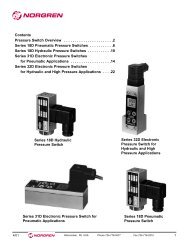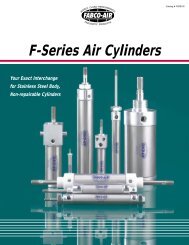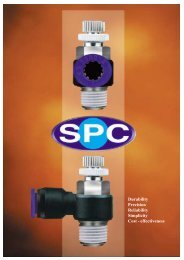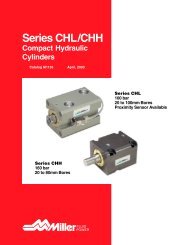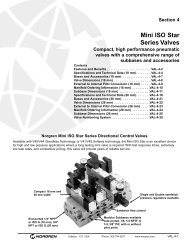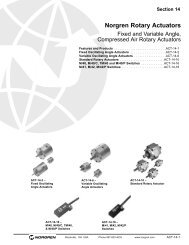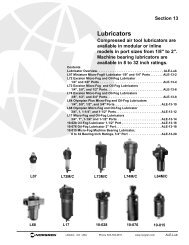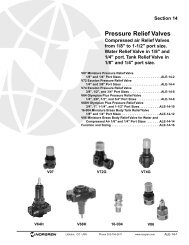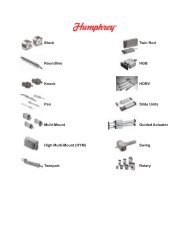Miller AL4 Series
Miller AL4 Series
Miller AL4 Series
- No tags were found...
Create successful ePaper yourself
Turn your PDF publications into a flip-book with our unique Google optimized e-Paper software.
<strong>Miller</strong> <strong>AL4</strong> <strong>Series</strong>Air CylindersStorageInstallationMounting RecommendationsCylinder Trouble ShootingStorageAt times cylinders are delivered before a customer is ready to installthem and must be stored for a period of time. When storage is requiredthe following procedures are recommended.1. Store the cylinders in an indoor area which has a dry, clean andnoncorrosive atmosphere. Take care to protect the cylinder fromboth internal corrosion and external damage.2. Whenever possible cylinders should be stored in a vertical position(piston rod up). This will minimize corrosion due to possiblecondensation which could occur inside the cylinder. This will alsominimize seal damage.3. Port protector plugs should be left in the cylinder until the time ofinstallation.4. If a cylinder is stored full of hydraulic fluid, expansion of the fluiddue to temperature changes must be considered. Installing a checkvalve with free flow out of the cylinder is one method.Installation1. Cleanliness is an important consideration, and <strong>Miller</strong> cylinders areshipped with the ports plugged to protect them from contaminantsentering the ports. These plugs should not be removed until thepiping is to be installed. Before making the connection to thecylinder ports, piping should be thoroughly cleaned to remove allchips or burrs which might have resulted from threading or flaringoperations.2. Cylinders operating in an environment where air drying materialsare present such as fast-drying chemicals, paint, or weld splatter, orother hazardous conditions such as excessive heat, should haveshields installed to prevent damage to the piston rod and piston rodseals.3. Proper alignment of the cylinder piston rod and its mating componenton the machine should be checked in both the extended andretracted positions. Improper alignment will result in excessive rodgland and/or cylinder bore wear. On fixed mounting cylindersattaching the piston rod while the rod is retracted will help inachieving proper alignment.Mounting Recommendations1. Always mount cylinders using the largest possible high tensile alloysteel socket head screws that can fit in the cylinder mounting holesand torque them to the manufacturer’s recommendations for theirsize.2. Side-Mounted Cylinders – In addition to the mounting bolts,cylinders of this type should be equipped with thrust keys or dowelpins located so as to resist the major load.3. Tie Rod Mounting – Cylinders with tie rod mountings are recommendedfor applications where mounting space is limited. Thestandard tie rod extension is shown as BB in dimension tables.Longer or shorter extensions can be supplied. Nuts used for thismounting style should be torqued to the same value as the tie rodsfor that bore size.4. Flange Mount Cylinders – The controlled diameter of the rod glandextension on head end flange mount cylinders can be used as apilot to locate the cylinders in relation to the machine. Afteralignment has been obtained, the flanges may be drilled for pins ordowels to prevent shifting.5. Trunnion Mountings – Cylinders require lubricated bearing blockswith minimum bearing clearances. Bearing blocks should becarefully aligned and rigidly mounted so the trunnions will not besubjected to bending moments. The rod end should also be pivotedwith the pivot pin in line and parallel to axis of the trunnion pins.6. Clevis Mountings – Cylinders should be pivoted at both ends withcenterline of pins parallel to each other. After cylinder is mounted,be sure to check to assure that the cylinder is free to swing throughits working arc without interference from other machine parts.Cylinder Trouble ShootingExternal Leakage1. Rod seal leakage can generally be traced to worn or damagedseals. Examine the piston rod for dents, gouges or score marks,and replace piston rod if surface is rough.Rod seal leakage could also be traced to gland bearing wear. Ifclearance is excessive, replace rod gland and seal. Rod sealleakage can also be traced to seal deterioration. If seals are soft orgummy or brittle, check compatibility of seal material with lubricantused if air cylinder, or operating fluid if hydraulic cylinder. Replace withseal material, which is compatible with these fluids. If the seals arehard or have lost elasticity, it is usually due to exposure to temperaturesin excess of 165°F. (+74°C). Shield the cylinder from the heatsource to limit temperature to 350°F. (+177°C.) and replace withfluorocarbon seals.2. Cylinder body seal leak can generally be traced to loose tie rods.Torque the tie rods to manufacturer’s recommendation for thatbore size.Excessive pressure can also result in cylinder body seal leak.Determine maximum pressure to rated limits. Replace seals andretorque tie rods as in paragraph above. Excessive pressure can alsoresult in cylinder body seal leak. Determine if the pressure rating of thecylinder has been exceeded. If so, bring the operating pressure downto the rating of the cylinder and have the tie rods replaced.Pinched or extruded cylinder body seal will also result in a leak.Replace cylinder body seal and retorque as in paragraph above.Cylinder body seal leakage due to loss of radial squeeze which showsup in the form of flat spots or due to wear on the O.D. or I.D. – Either ofthese are symptoms of normal wear due to high cycle rate or length ofservice. Replace seals as per paragraph above.Internal Leakage1. Piston seal leak (by-pass) 1 to 3 cubic inches per minute leakage isconsidered normal for piston ring construction. Virtually no static leakwith lipseal type seals on piston should be expected. Piston seal wearis a usual cause of piston seal leakage. Replace seals as required.2. With lipseal type piston seals excessive back pressure due to overadjustmentof speed control valves could be a direct cause of rapidseal wear. Contamination in a hydraulic system can result in a scoredcylinder bore, resulting in rapid seal wear. In either case, replace pistonseals as required.3. What appears to be piston seal leak, evidenced by the fact that thecylinder drifts, is not always traceable to the piston. To make sure, it issuggested that one side of the cylinder piston be pressurized and thefluid line at the opposite port be disconnected. Observe leakage. Ifnone is evident, seek the cause of cylinder drift in other componentparts in the circuit.Cylinder Fails to Move the Load1. Pneumatic or hydraulic pressure is too low. Check the pressure at thecylinder to make sure it is to circuit requirements.2. Piston Seal Leak – Operate the valve to cycle the cylinder and observefluid flow at valve exhaust ports at end of cylinder stroke. Replacepiston seals if flow is excessive.3. Cylinder is undersized for the load – Replace cylinder with one of alarger bore size.4. Piston rod broken. Bring the operating conditions of the cylinder to theattention of our engineering department and have our factory repair thecylinder.Erratic or Chatter Operation1. Excessive friction at gland or piston bearing due to load misalignment–Correct cylinder-to-load alignment.2. Cylinder sized too close to load requirements – Reduce load or installlarger cylinder.3. Erratic operation could be traced to the difference between static andkinetic friction. Install speed control valves to provide a back pressureto control the stroke.56


